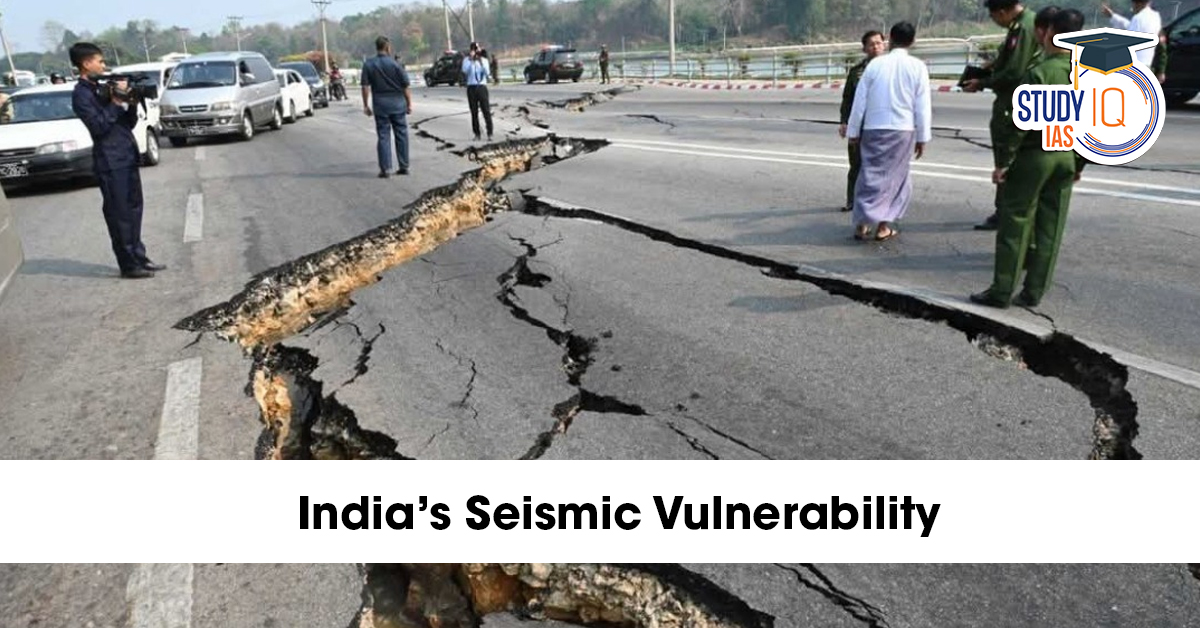Table of Contents
Context: The July 2025 Delhi earthquake highlights India’s seismic fragility, especially in urban areas like Delhi, and underscores the urgent need for nationwide structural and policy-based preparedness.
India’s Seismic Vulnerability
- Tectonic Setting: India lies on the Indian Plate, which is colliding with the Eurasian Plate at ~5 cm/year, generating high seismic activity, especially in the Himalayan belt.
- Seismic Zones: 58% of India’s landmass falls in Seismic Zones III–V, with Zone V (very high risk) covering regions like Northeast India, Kashmir, Himachal Pradesh, Andaman-Nicobar, and parts of Bihar and Gujarat.
- Urban Fragility: Cities like Delhi, Guwahati, Bhuj, and others are built on liquefaction-prone soils, with dense populations and unsafe structures.
- Building Non-Compliance: Over 80% of buildings in Delhi (especially those built before 2000) do not follow seismic codes, as per IS 1893:2016.
Why Vulnerability Still Persists
- Lax Enforcement: Seismic codes (like IS 1893) exist but are poorly enforced, especially for older or private structures.
- Poor Urban Planning: Rapid, unplanned urbanisation, especially in high-risk zones, has led to unsafe and unauthorised construction.
- Lack of Retrofitting: Few older buildings have been structurally retrofitted with quake-resistant technology like steel jacketing, shear walls, or base isolation.
- Low Public Awareness: People are largely unaware of earthquake preparedness, emergency protocols, and safety drills.
- Inadequate Funding: Retrofitting and disaster mitigation require large investments (₹50,000 crore/year as per estimates) that are often deprioritized.
How It Can Be Resolved
- Policy and Regulatory Measures: Strict implementation of seismic design codes (IS 1893:2016) across all zones.
- Launch national-level retrofitting schemes for vulnerable buildings, especially in Delhi, Guwahati, Bhuj, etc.
- Infrastructure Resilience: Adopt ductile concrete (Thailand using high-strength ductile concrete (30–40 MPa)), deep pile foundations, and base isolation (Post 2001 earthquake, Bhuj District Hospital was reconstructed using base isolation technology) in new constructions.
- Tailor structures based on local soil types — e.g., soft soils in Northeast India, sandy basins in Kutch.
- Technological Strengthening: Strengthen tools like the IndiaQuake app, and extend real-time alerts to rural and high-risk zones.
- Use spatial data to identify risk hotspots and monitor land deformation.
- Community and Awareness: Promote awareness on emergency kits, structural safety, and earthquake response drills.
- Mandate regular drills and safety audits.
- Financial Mechanisms: Promote earthquake insurance for households and businesses.
- Allocate targeted disaster funds at the central and state levels for retrofitting and monitoring.


 Places in News for UPSC 2026 for Prelims...
Places in News for UPSC 2026 for Prelims...
 Lake Natron: Location, Features, Wildlif...
Lake Natron: Location, Features, Wildlif...
 Erra Matti Dibbalu Added to UNESCO Tenta...
Erra Matti Dibbalu Added to UNESCO Tenta...

























